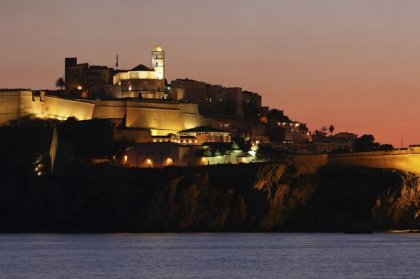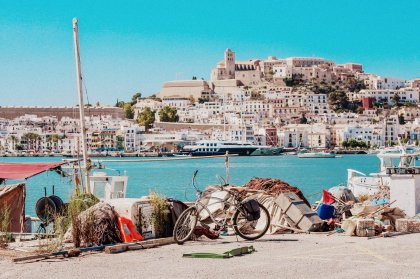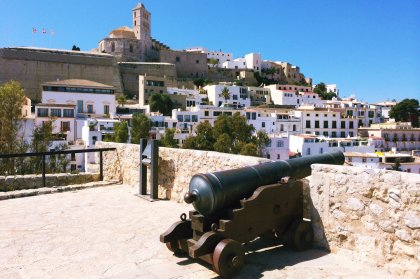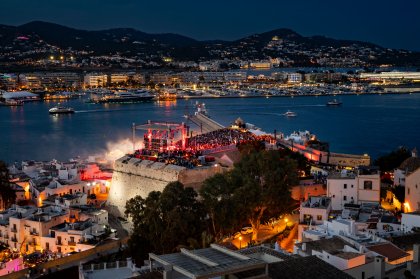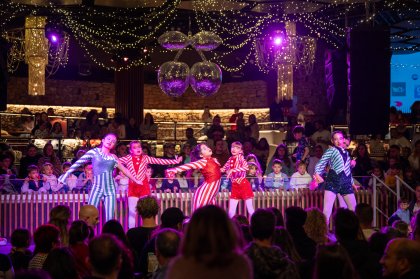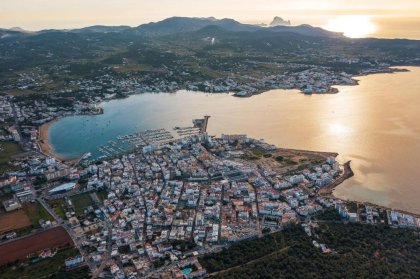Perched atop a small mountain next to the sea, the fortified old town of Dalt Vila, with the cathedral at the top, dominates the skyline of Ibiza Town.
From this privileged position, Dalt Vila, which translates to "Upper Town," looks down over the beautiful winding streets of the old fisher quarters and the sparkling harbour below.
City walls, squares and narrow lanes
On the hill where Dalt Vila sits today, the Phoenicians, named the Punic people by the Romans, founded the city of Ibossim. This then became one of the most important trading centres in the Western Mediterranean.
Over the centuries, further civilisations, such as the Romans and the Moors, began to settle, influencing its architecture, growth, and further development.
The most striking of these are the Renaissance-era defensive walls that surround Dalt Vila. Ordered by King Charles I and King Philip II of Spain to defend against the invading French and the Ottoman Empire, their successful resistance is now a timeless and beautiful sight for all to enjoy.
Exploring Dalt Vila
Exploring this vast melting pot of history, ancient buildings, and walls can provide hours of enjoyment. The best way to explore it is on foot, where you can wander around the narrow, winding, and sometimes steep cobbled streets, marvelling at the magnificent views from the arrowslits in the high ramparts and the expansive terraces on each level.
The citadel is still a lively neighbourhood, with many residents living alongside beautiful boutique hotels, romantic restaurants, and small fashion boutiques. As you walk through the narrow streets, laundry hangs from balconies with wrought-iron railings, with flowering pink bougainvillaea offering a striking contrast to the whitewashed houses.
Dalt Vila is a treasure trove of surprises and perfect photo moments at every corner. Sometimes, the best discoveries come when you simply wander aimlessly. We recommend wearing comfortable shoes, so you can lose yourself amongst the many beautiful twists and turns for the whole day.
Routes and guided tours
For a deeper insight and a little guidance in navigating this charming maze, consider joining one of the free guided walking tours. They are led by knowledgeable locals who will breathe life into the ancient stones with fascinating historical tales and stories of the past.
If you’d prefer to walk at your own pace, there are many information plaques in multiple languages placed throughout. These give you a chance to learn at your leisure and create your personalised journey through time.
Further information is available from the tourist information office at the square next to the cathedral at the top of Dalt Vila.
City gates, squares and bastions
The main city gate, Portal de Ses Taules, sits at the end of a steep stone drawbridge. This dramatic entrance leads you into an ancient cobbled stone courtyard, opening onto the lively main square of Plaza de Vila.
Bustling with restaurants, their pretty terraces line the cobbled streets, attracting diners to rest in between browsing boutiques and artisan shops, picking up handcrafted goods, beautiful clothes, and jewellery.
At night, the area becomes lit in a haze of glowing candles, turning it into a romantic masterpiece.
If you walk the street up to your left, you’ll find a bronze statue honouring Isidor Macabich, Ibiza’s pioneering priest and historian. He was the first person to study the island's past in great depth, and many streets in Ibiza now carry his name.
Further along, you’ll find steps that lead up to the bastion Baluarte de Santa Lucía. Here, old cannons remind us of the days when the city still had to defend itself against pirates. Magnificent views open up of the harbour and the old fishing districts below the city walls.
Another entrance into Dalt Vila leads from Plaza del Parque through Carrer del Comte de Roselló, where the world-class Contemporary Art Museum resides.
Downstairs, you’ll find the remains of an ancient Phoenician home. Trading in salt, silver, gold, and even delicacies like dried salted fish, the Phoenicians built the city into a trading power, and are who the island has to thank for building what came to be an impenetrable fortress.
Behind Plaza de Reina Sofía, you will find another entrance into Dalt Vila. The Portal Nou is a 50 metre long tunnel with stairs that lead up to the Plaza del Sol. A charming square, it is lined with quaint bars and restaurants, with pretty terraces where locals and holidaymakers can sit for hours and watch island life go by.
From here, you can walk up along the city walls to the cathedral at the top, or descend to the main square of Plaza de Vila, mentioned before. The climb to the top is well worth it, as the summit affords you some magnificent views of the vibrant city below, as do the breaks in the high ramparts and the vast terraces at each level.
As you journey on up, you’ll pass the bastion of San Jaime (Sant Jaume in Catalan), where a small but very informative military museum brings the city's defensive history to life. Stop in to see the fascinating exhibition and displays of historical weapons, including cannons, mortars, muskets and swords. It also features multimedia panels that explain how the artillery and defence systems have developed.
It's also interactive, allowing visitors to try on armour, hold weapons in their hands or lift cannonballs and mortar shells – a particularly popular activity among children and families.
The Patron Saint San Ciriaco
The Catalans were the first to penetrate Dalt Vila from within and, by doing so, crushed the current Moorish rule. As legend has it, the brother of the emir, who controlled Ibiza at the time, was deeply jealous of his sibling and so betrayed him to the Catalan pretenders.
He told them the whereabouts of a secret tunnel that led from the sea into the fortified castle. Secretly entering the so far impenetrable walls, this led to the victory of the Catalans over the Moors.
The exit of the tunnel can still be seen behind bars in the cobbled lane of Carrer Mayor leading up to the cathedral. Here, the Catalans built a small chapel, which was named in honour of San Ciriaco, the Patron Saint of Ibiza.
In honour, every year on 8 August, the sky lights with colourful cackles and booms as the Saint is celebrated with a giant firework display, to signify the defeat of the Moors.
Restaurants and bars
Could there be anything more incredible than a candlelit dinner in a medieval castle, as the stars twinkle above?
Within the city walls, there are many fantastic restaurants, with stunning terraces and marvellous menus to feast upon. Watch the world go by as you dine and drink, taking in the vibrant life that’s played out both day and night from this beautiful vantage point.
Wondering slowly along the streets, resting for coffee, tapas, and a beautiful chilled vino is one of the pleasures of spending time in this area. It's a real experience of the more relaxed Spanish and Ibizan way of life.
Thanks to its stunning location, many eateries within the walls may be at the higher end of the pricing spectrum; however, there are still many fantastic options to suit all budgets.
The cathedral
At the top of the citadel, the cathedral dominates the views of Dalt Vila. The Cathedral of the Virgin of the Snows (Catedral de la Verge de les Neus in Catalan) was built in the 14th century, shortly after the Christian reconquest of Ibiza. After several renovations, it was finally consecrated in 1785.
Open to the public to visit, once inside, notice the decorated walls adorned with beautiful paintings, stained glass windows and the impressive altar. The cathedral also keeps many notable and valuable works of art, including a Gothic monstrance of gold and silver and two Gothic panels, along with a well-preserved set of bells from the 16th and 17th centuries.
Looking down from the square in front of the cathedral, you are met with sweeping views out over the city, the harbour and the sea, which stretches out as far as Ibiza’s stunning sister island, Formentera.
From here, you can spend hours gazing out upon the boats and pretty yachts whizzing by, playing in the vast and shimmering Mediterranean Sea.
Below you’ll also spot red-tiled domes of the 16th-century church of Santo Domingo, which is located next to the historic town hall.
To the right of the cathedral, you can follow a steep cobbled lane up to the large bastion Baluarte de San Bernat. From its top you'll have stunning views over Figueretas, Playa d’en Bossa and the salt flats, with Formentera in the distance.
Nearby, you could explore the old passageways. As you go back towards the cathedral, you’ll encounter a tunnel, which leads through the city walls to a car park. From the other side of this car park, another longer tunnel then leads back into Dalt Vila, down to the Plaça de Espanya in front of the historic town hall.
Exploring here always has a special thrill to it and feels like an adventure through Ibiza’s past.
Party in medieval surroundings
Once a year, at the beginning of the summer season, a very special party happens on the bastion of Santa Lucía, the Grand Finale of the International Music Summit. While the sun sets, huge international DJs play on a grand open-air stage, as crowds form and enjoy one of the finest dancefloor views in the world.
The latest music is showcased here, played within the ancient walls and grounds of Ibiza's past, a celebration that fuses the island's rich history with its vibrant present.

































